Earlier this year, on a cold January morning, I was walking around in the snowy streets of Stockholm, not sure how to spend the few hours before the departure of my bus on an 18-hour journey to the far north of Sweden, when I came across a big brown church in a side street near the main train station. Being interested in religion, I decided to walk in and have a look in order to get an impression of Swedish churches.
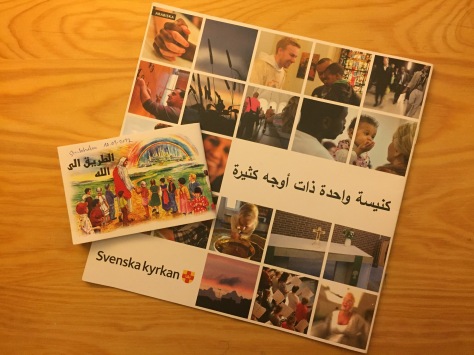
Two different Christianities in two booklets
When I went in, which was few minutes after it had opened its doors to visitors, there were already 5 or 6 people inside. Some of them seemed to be homeless people who spent the night inside protected from the freezing cold. They wore rough clothes and had blankets and mats with them. There were also two people praying and another person sitting near the door, who, I assume, work for the church.
When you live in Europe for a long time, churches cease to impress to you. They all look, more or less, the same—only the size and the details may vary. It appears as if there were few master models, from which all churches were copied. The Klara Church—this is how the church is called—was no exception. Yet, I was a little bit intrigued by the ceiling paintings. They, as usual, depict scenes from the life of Jesus, but for some reason they seemed more “Oriental” or even “Orientalist” than usual to my eyes with figures, including Jesus if I remember correctly, wearing Arab- or Turkish-style turbans. I wondered whether Western Christian art tended to depict Jesus in a non-Oriental fashion because of rivalry with Muslims in the Middle East and whether this rather Orientalist style of art in this church had to do with friendly relations between the Ottoman Empire and Protestants in Europe during the first two centuries of the Reformation.
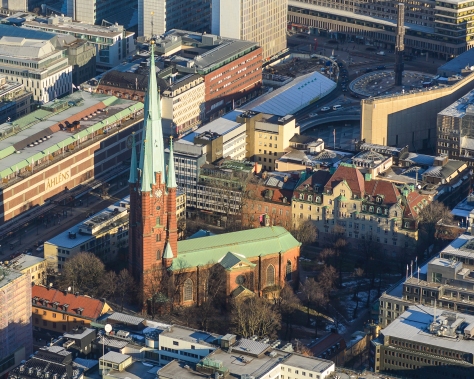
The Klara Church, Stockholm, Photo by Arild Vågen via Wikimedia Commons
Anyway, Christian art is not the subject of this blog post, but two booklets in Arabic that I picked up from a stand on my out of the church. I am personally interested in “religious marketing”, so whenever I had the chance, I would collect booklets or leaflets that are being distributed on streets or displayed on stands. Later that day, during my 18-hour bus journey, I had the chance to go through them. I was amazed to find out how contrasting, if not contradictory, their messages are, even though they were lying side by side in the same church.
The first one, which is bigger in the size of its papers and fancier in its production, is an official publication of the Swedish Lutheran Church, which was until 2000 the state church in the country. Its title can be translated as “One Church with Many Faces” (Obviously, “Faces” here indicates diversity, not hypocrisy). The cover, which you can see below, displays many shiny photos of happy men and women of different ages and ethnicities. They almost look like stock photos that you typically find in brochures and websites of companies, universities, and NGO’s. The 14-page booklet, indeed, has fairly little text and many photos. It describes the Swedish Church as open for all people regardless of their culture, nationality, religion, or even belief in God. “The Swedish Church is open for all, the believer as well as the skeptic,” it reads on the first page. It asserts that belief or faith is something personal, immeasurable, and prone to doubt.
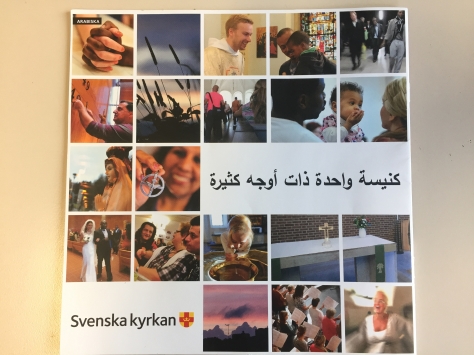
The cover of the first booklet, which is a publication of the Swedish Lutheran Church
Christian symbols, such as the cross, are there, but they do not by any means dominate the visual representation of the booklet. They are just one among many symbols and aspects of life.
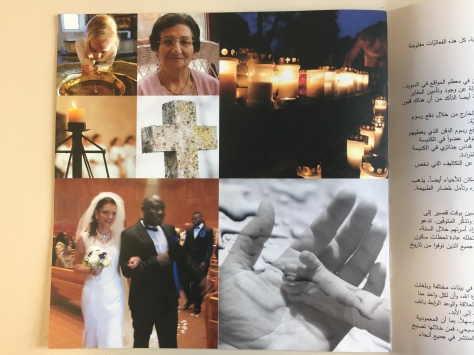
It is people, not the cross or any other religious symbol, which dominate the page
Focus in the booklet is not on what the person should believe about God or Jesus but rather on what the church does for the individual and society. It highlights that it organizes social activities for the youth and the elderly, provides counselling (including a hotline with an on-duty priest), sends aid to third-world countries (naturally, with the typical image of the hungry African child), and supports some (non-controversial) public causes, such as climate change and charity for the poor. The church, additionally, presents its self as part of the cultural heritage of Sweden and a promoter of cultural activities, especially music. The publication contains as well some details about the organization of the church: membership, financing, and the appointment of officials. Interestingly, the Swedish Church follows a democratic mode of governance, according to the booklet, with officials elected directly every four years.
The above issues are not religious in the strict meaning of the term and could very well be provided by non-religious organizations. The only aspects that this booklet deals with, which one may describe as explicitly religious are related to rites of passage or “limit-situations” (birth, baptism, confirmation, marriage, death), which are still popular in Sweden: In 2008, 40% of marriages were conducted by the church, 60% of newborns were baptized, and 83% of burials were carried out by the church. Given that 64% of Swedes are members of the church, yet only 29% of them say they are religious and mere 2% attend worship services regularly [link], it seems that for most church members, these ceremonies are about something other than religion—or, to be more specific, something other than belief and worship.
God and Jesus are mainly mentioned in the 3 prayers printed on the two pages shown below, among which is the Lord’s Prayer. However, no commentary is given about their interpretation and it is left to the reader to derive the meaning they want from them. It is asserted elsewhere in the booklet that there is meaning in life, but it is not expressed in theological terms in reference to God, but rather affectively— joy, sadness, despair, etc.—in reference to inter-human encounters. This is clear from the background picture for the text of the prayers, which show two interlocked hands of a black man and a white woman.
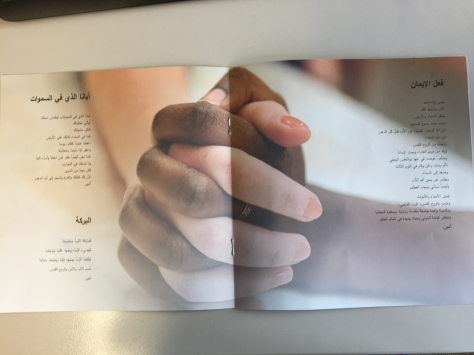
The text of the 3 prayers with the background picture
This presentation is typical of mainstream, especially Protestant, churches in secularized countries, where their authority has steadily diminished; not only in politics but also in various other social domains, such as education, science, economy, and personal morality. These churches have by and large accepted the secular paradigm and contented itself with the space circumscribed to it by the state, capitalism, and different secular ideologies. They liberalized their interpretation of scriptures to become more consistent with the scientific worldview, ceased to police the behavior of people in their private lives, and refrained from intervening in the making of laws and the political management of society. I am not suggesting that they have become irrelevant, but that their relevance became limited to very specific domains. At any rate, the recent history of these churches is largely consistent with the secularization theory in its classical formulation, whereby religion is declining in membership, scope, and authority.
The other booklet represents an entirely different worldview, even though it was lying there beside the first one on that stand in the Klara Church. In terms of production, it is much smaller in paper-size and far lower in quality. The cover is colored, but the pages, which reach almost 50 in number, are black and white. It is full of text and contains no photos, but some primitive hand drawings. The cover of the booklet has the title “The Road to God” over a drawing of Jesus showing a group of children the road to what appears to be Heaven or the Kingdom of God. Apart from representation, the two booklets could not be more different in their messages, even though both are Christian.
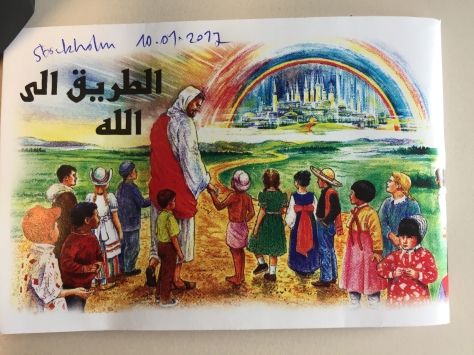
The cover of the second booklet
This second booklet starts by stating the God created our world and gave it to Adam. “To know what happened,” the reader is invited on page 1 to read further. The booklet proceeds then to tell the story of the original sin, the banishment of Adam, God sending his Son to save Mankind, and so forth. In-between, the text makes several assertive statements regarding faith, reality, and morality. It insists that “Jesus is God—in a Human Form”, “Hell is a real place” and so is Heaven. “Jesus will come again” and the “all will rise from the dead.” The text is full of either… or…, if…then…. statements:
- Either you believe in Jesus and attain salvation or the wrath of God will befall you.
- If you accept Jesus, then you are saved.
The booklet leaves no room for choices: “Jesus is the only road to eternal life” and so it commandingly states: “we have to choose Jesus.” It constantly challenges the reader with questions such as: “Which road are you taking: Jesus or the Devil?” This particular sentence is supplemented with a drawing showing two road signs pointing to opposite directions: one is “Eternal Life” and the other is “Eternal Death.”
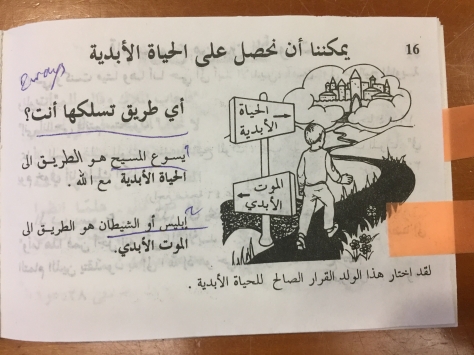
Which way will you choose: “eternal life” or “eternal death”?
In addition to affirmative statements about this world and the hereafter, the text is contains specific moral commandments concerning sexual life, drinking, and relations with other humans: do not commit adultery, do not get drunk, do not steal, etc.
The faith offered by the second booklet is very simple and specific. It offers manual-like guides to attain salvation, for example: “How to attain eternal life? Follow the steps at the beginning of page 24,” which are formulated in the imperative: admit that you are a sinner; repent from your sins; believe in Jesus; etc.
There is no talk here of many faces for the church, plurality of ways to reach God, the immeasurability of faith, or the unavoidability of doubt. Belief here is something very simple, unambiguous, and perfectly measurable: if you subscribe to certain “truths”, you are alright, otherwise you burn in hell. It is an epistemic faith: it is about what really happened; not about some vaguely described emotional moments of joy and sorrow during some inter-human interactions. Affirmative statements are almost absent or left vague in the first booklet, whereas they are abundant in the other one. The second booklet extensively employs the Arabic equivalents of auxiliary verbs such as “is” and “will” which affirm certainty about the present and the future respectively: it is like that, it will happen in this way. It warns of Hell, which is anything but symbolic: a place where people burn and suffer. No room is given here to subjective interpretations and hermeneutic games.
At the beginning I was a bit confused how come this booklet is distributed by the Swedish Church. I looked for bibliographic details, and, not to my surprise, it turned out not to be from the Swedish Church, but from an organization that calls itself “Voice of Preaching the Gospel” with its address in Colorado, the United States. It does not say, however, to which church this organization belongs. Later on, when I googled its name, I came across this website, which is in Arabic: www.vopg.org The website does not say either to which church, denomination, or Christian group it belongs. It contains Articles written by what appears to be Arab Christians in the United States about various topics—mostly of missionary, apologetic, or moralist nature.
Since the website and the booklet hardly contain institutional references, it cannot be that this group belongs to an established Arabic-speaking church (such as the Coptic Church in Egypt or the Maronite Church in Lebanon). I suspected them to be of Jehovah Witnesses, but the website lists a polemic book that warns of the “heresy of the Jehovah Witness”, which one can order. So I guess they are not.
Anyway, they are probably some dissident USA-based Arab Christian group that does missionary work among Arabs and engage in sectarian polemics against other groups, especially Muslims. How did this booklet end up there on a stand inside a church that belongs to the Swedish Church, which would certainly not like to associate itself with any active missionary work among Muslims nor with such an assertive and dogmatic version of Christianity? I do not have answer to this question and it is not of particular interest to me. Probably someone had sneaked it in-between the many booklets on that stand without church officials realizing that. Maybe some low-ranking official is implicit in such activity, but almost certainly not the leadership.
At any rate, I am here merely interested in the stark contrast between the two forms of religiosity expressed in these two booklets. One speaks of emotions, charity, plurality of life-styles, and inclusiveness and another one speaks of facts, missionary work, moralism, and exclusiveness. The first one has made many concessions to the secular social and epistemic order, whereas the other one was less willing to compromise. While many people think that the second form of religion does not belong in the modern world and should have disappeared long time ago, it thrives, as opposed to mainstream churches, whose demographics are shrinking. Evangelicals, Pentecostals, Mormons, Jehovah Witnesses, to mention few examples, are growing or having fairly steady membership, even though (or perhaps because?) they did not compromise their theology, moral demands, and authoritative nature.
It seems that, at least as far as Europe and North America are concerned, secularization has produced a double effect: less overall religiosity, but also growing, socially active, well-organized conservative or even fundamentalist religious groups. The so-called “religious nones” (e.g. atheists, agnostics, the irreligious) are also growing steadily in these societies, especially among the younger generations, which suggest that in the mainstream Christianity is under pressure from two sides: the non-religious and the strongly religious. I am not suggesting here that mainline or liberal churches, like the Swedish one, are going to disappear any time soon, but we might need to consider in the near future, if the currents trends remain steady, whether they are becoming less religious organizations and more like “compassionate NGO’s”, in the words of Pope Francis.
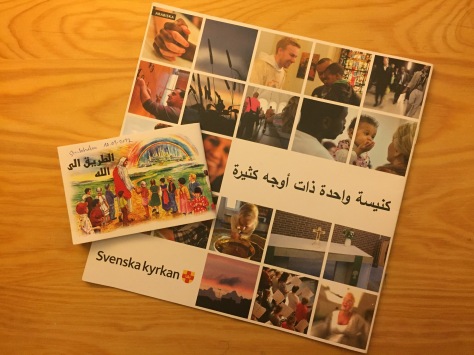
The two booklets together
[…] some reason, I find religious leaflets interesting. Previously in this blog, I wrote a post comparing two brochures that I had picked up in a church in Stockholm, Sweden. […]